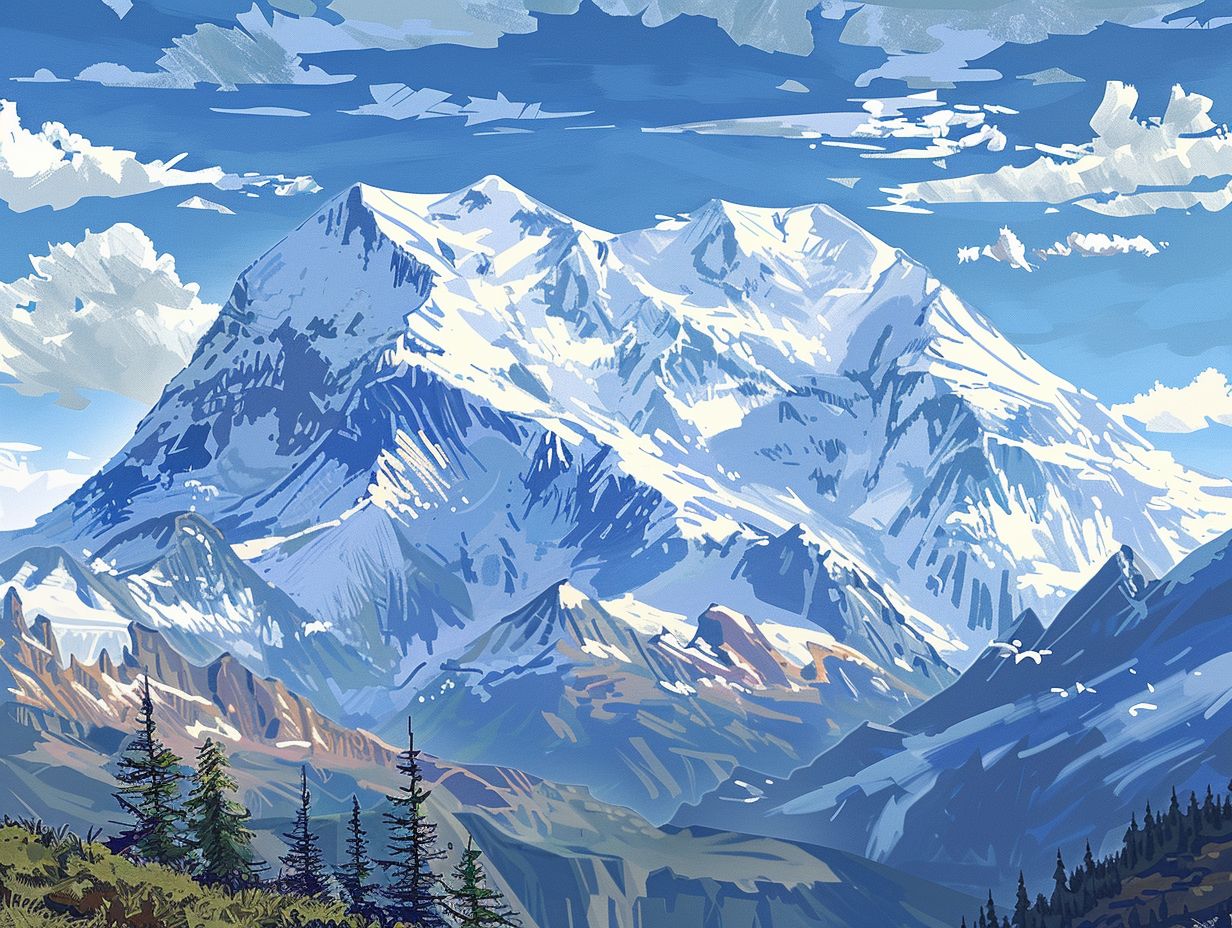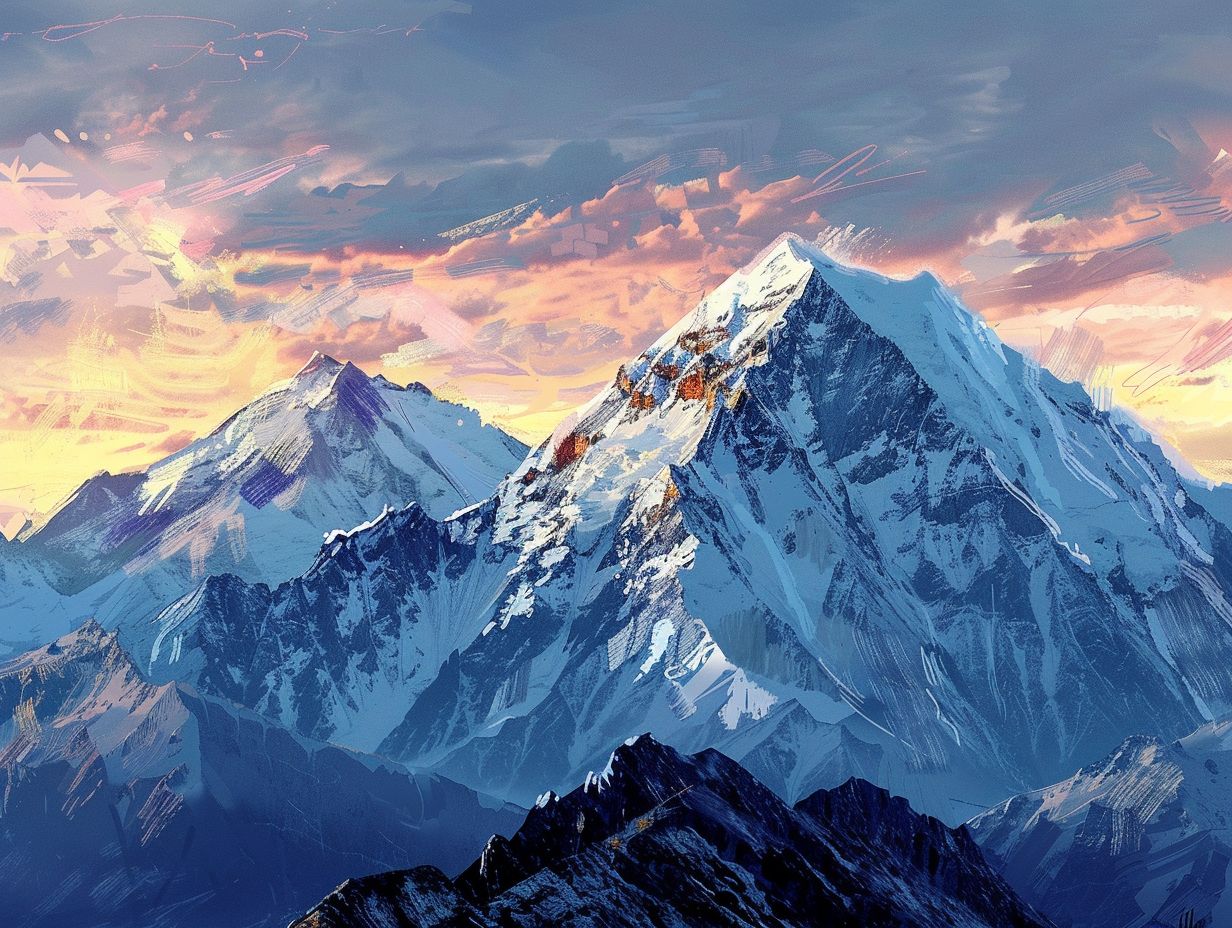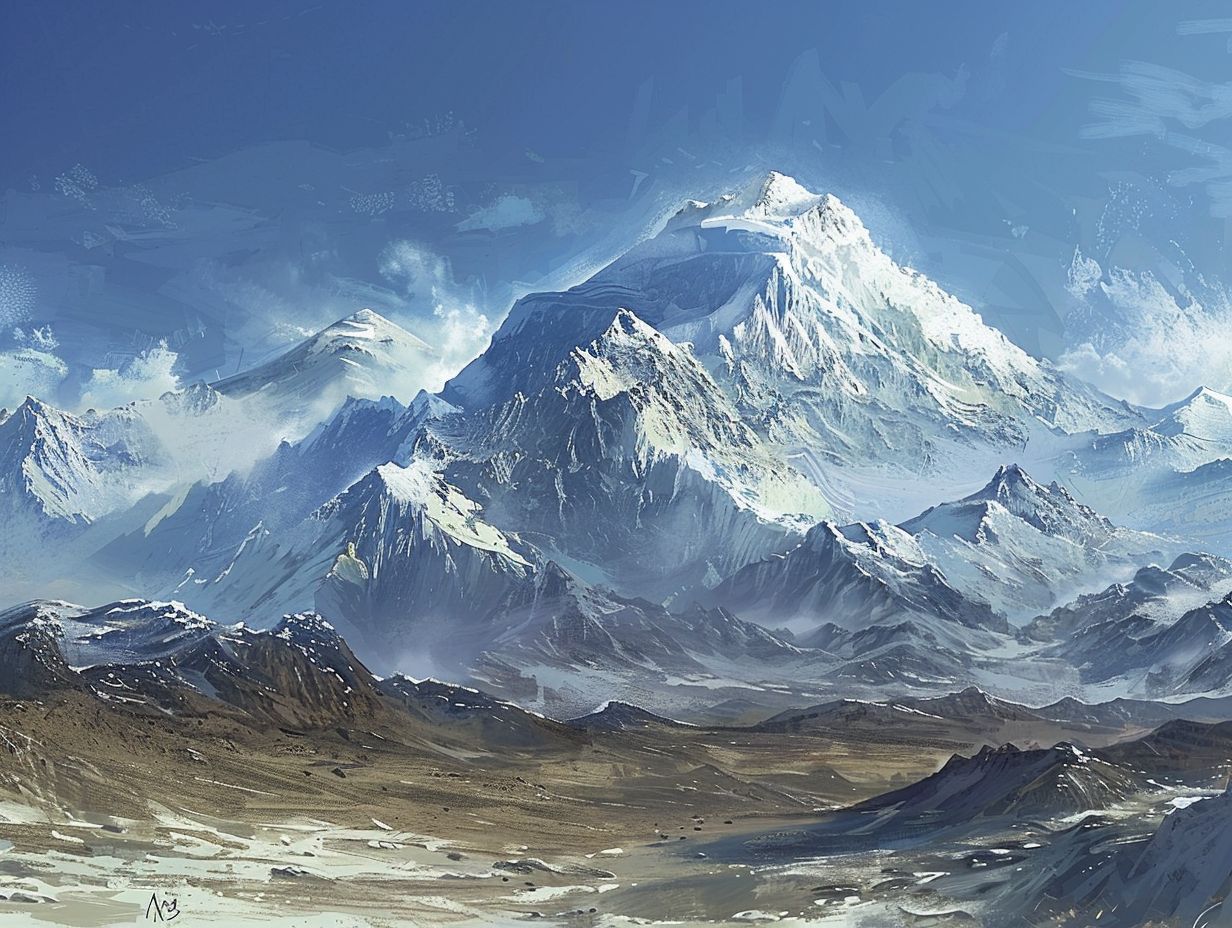
Kilimanjaro Vs Denali
Ever wondered where the majestic peaks of Kilimanjaro and Denali are located? Or perhaps you’re curious about their elevation, landforms, and climate differences?
In this article, we will explore the geography and climate of these two iconic mountains, as well as delve into their rich history and cultural significance.
We will discuss the popular trekking and climbing routes, difficulty levels, and requirements for those seeking to conquer these legendary summits.
Join us on a virtual journey to discover the wonders of Kilimanjaro and Denali!
Key Takeaways:

- Kilimanjaro and Denali are two iconic mountains located in different continents, Africa and North America respectively.
- Both mountains have impressive elevations and prominence, with Kilimanjaro being the highest free-standing mountain and Denali being the highest peak in North America.
- The geography, climate, and trekking routes of Kilimanjaro and Denali differ greatly, offering unique experiences for those seeking to climb these majestic peaks.
Where Are Kilimanjaro and Denali Located?
Kilimanjaro is located in Tanzania, while Denali is situated in Alaska. Both mountains are renowned for their challenging climbs and majestic views.
Kilimanjaro, standing at approximately 19,341 feet above sea level, is geographically located at coordinates 3.0759° S latitude and 37.3530° E longitude. It is part of the Kilimanjaro National Park, which is surrounded by lush rainforests and diverse wildlife like elephants and leopards.
On the other hand, Denali, formerly known as Mount McKinley, is positioned at approximately 63.0695° N latitude and 151.0070° W longitude. It is the centerpiece of Denali National Park and Preserve, offering stunning vistas of glaciers and alpine tundra.
What Are the Elevation and Prominence of Kilimanjaro and Denali?
Kilimanjaro stands at an elevation of approximately 5,895 meters (19,341 feet), making it the highest peak in Africa. On the other hand, Denali reaches an elevation of about 6,190 meters (20,310 feet), making it the highest peak in North America.
These staggering elevations present unique challenges for climbers attempting to conquer these formidable mountains. Kilimanjaro’s prominence affects climbers as they ascend through different ecological zones, each marked by a significant change in climate and terrain.
The altitude of Denali poses additional obstacles due to its harsh, unpredictable weather conditions and the risk of altitude sickness that becomes more pronounced with every meter gained. The thin air, low temperatures, and steep inclines add layers of difficulty, testing the physical and mental resilience of those determined to reach the summit.
Geography and Climate of Kilimanjaro and Denali:
The geography and climate of Kilimanjaro and Denali play a crucial role in shaping the experiences of climbers and expedition teams. From the equatorial forest surrounding Kilimanjaro to the icy expanses and high winds of Denali, these mountains offer a diverse range of terrains and weather conditions for adventurers to navigate.
-
What Are the Landforms and Features of Kilimanjaro?
Kilimanjaro boasts a unique blend of landforms, including the lush equatorial forest at its base that transitions into rocky terrains, glaciers, and challenging crevasses as climbers ascend towards the summit. The mountain’s diverse features offer a captivating journey for climbers with varying landscapes and ecosystems.
As climbers progress from the verdant rainforest at the mountain’s foothills, they gradually encounter the alpine deserts, characterized by sparse vegetation and harsh conditions. The stark beauty of this barren landscape provides a stark contrast to the dense foliage below.
Moving higher, trekkers navigate through the moorland zone, where unique flora like giant groundsels and lobelias dot the landscape, adding a surreal touch to the climb.
-
What Are the Landforms and Features of Denali?

Denali’s rugged landscape is characterized by vast expanses of snow and ice, towering granite peaks, and challenging rock-climbing sections that test the skills and endurance of climbers. The mountain’s features combine to create a formidable and awe-inspiring environment for those seeking to conquer its heights.
Denali, also known as Mount McKinley, is North America’s highest peak, rising majestically to an elevation of 20,310 feet. This snow-covered giant in Alaska’s wilderness beckons adventurers from around the world with its pristine beauty and extreme conditions.
The icy glaciers that adorn its slopes present a formidable challenge to even the most experienced climbers, requiring technical expertise and strategic planning to navigate safely. Amidst its granite formations, crevasses, and avalanche-prone areas, Denali’s harsh yet stunning terrain offers a thrilling but arduous test of mountaineering skills and grit.
-
How Does the Climate Differ between Kilimanjaro and Denali?
The climate variance between Kilimanjaro and Denali is stark, with Kilimanjaro experiencing fluctuating temperatures as climbers traverse through different ecological zones, while Denali presents extreme cold, high winds, and heavy snowfall that pose significant challenges even during the summer climbing season.
One of the key distinctions between the two mountains is the risk of altitude-related illnesses, which is higher on Kilimanjaro due to its rapid elevation gain compared to Denali’s gradual ascent.
The snowfall patterns differ significantly, with Kilimanjaro receiving sporadic snow mainly at higher altitudes, while Denali experiences consistent and heavy snowfall throughout the year, making navigation and climbing more demanding.
The impact of high winds sets these peaks apart; Denali is notorious for its fierce gusts that can reach hurricane levels, posing a danger to climbers, whereas Kilimanjaro’s winds are relatively milder in comparison, although still requiring caution during the ascent.
History and Culture of Kilimanjaro and Denali:
The history and culture surrounding Kilimanjaro and Denali are rich with tales of daring expeditions, cultural significance to indigenous communities, and the enduring spirit of climbers who have ventured to conquer these iconic peaks. From the earliest recorded climbs to the modern-day expeditions, these mountains hold a special place in the hearts of adventurers and local cultures alike.
-
What Is the History of Mount Kilimanjaro?
The history of Mount Kilimanjaro is a tapestry woven with the tales of pioneering climbers such as Richard Bass, Pat Morrow, and Rob Hall, who undertook remarkable expeditions to conquer its summit. Over the years, Kilimanjaro has witnessed numerous milestones in mountaineering history, shaping the mountain’s legacy as an iconic peak for adventurers around the globe.
Richard Bass, a successful businessman turned passionate climber, made history in 1985 by becoming the first person to complete the Seven Summits challenge, which included conquering Kilimanjaro.
Pat Morrow, a renowned Canadian mountaineer and filmmaker, added to Kilimanjaro’s lore with his breathtaking expedition in the 1980s, capturing the essence of the mountain’s beauty through his lens.
Rob Hall, a legendary New Zealand mountaineer, led expeditions up Kilimanjaro and Everest, showcasing his leadership and mountaineering skills.
-
What Is the History of Denali?
Denali’s history is marked by intrepid explorers and climbers like Gary Ball and Gavin Bate, whose expeditions have contributed to the mountain’s legacy as a challenging and revered peak. From the first successful ascent to modern-day feats, Denali’s history reflects the spirit of adventure and triumph in the face of extreme conditions.
One of the most iconic expeditions in Denali’s history was the 1967 Wilcox expedition, which accomplished the first winter ascent. This daring feat solidified Denali’s reputation as one of the most difficult mountains to conquer.
Notable climbers like Bradford Washburn and Riccardo Cassin further added to the lore of the mountain by pushing the boundaries of what was considered possible. Their contributions paved the way for future generations of climbers who continue to be drawn to Denali’s majestic slopes.
-
What Are the Indigenous Cultures Surrounding Kilimanjaro and Denali?

The indigenous cultures surrounding Kilimanjaro and Denali are deeply intertwined with the mountains’ histories, with local communities playing vital roles as guides, porters, and stewards of the land. These cultures bring a rich tapestry of traditions, beliefs, and practices that add cultural depth to the climbing experiences on both mountains.
For centuries, these communities have passed down knowledge from generation to generation, emphasizing respect for nature, ancestral spirits, and the interconnectedness of all living beings.
The rituals and ceremonies performed before embarking on a climbing expedition reflect a profound connection to the mountains, seeking blessings for a safe journey and successful summit.
By partaking in these practices, climbers engage in a form of cultural exchange, bridging worlds and fostering mutual understanding.
The integration of indigenous perspectives into mountain climbing not only enriches the experience for climbers but also supports the preservation of cultural heritage and sustains community livelihoods.
Trekking and Climbing Kilimanjaro and Denali:

Trekking and climbing Kilimanjaro and Denali demand physical endurance, technical skills, and a deep appreciation for the challenges and rewards of high-altitude expeditions. From the popular routes that attract climbers worldwide to the stringent requirements for ascent, each mountain offers a test of skill, determination, and adaptability in the face of varying terrains and extreme conditions.
-
What Are the Popular Routes for Trekking and Climbing Kilimanjaro?
Kilimanjaro presents climbers with a variety of popular routes, each offering a unique perspective of the mountain and its surroundings. From the bustling base camps to the high-altitude challenges, these routes cater to climbers of different skill levels, emphasizing the importance of acclimatizing, expert guidance, and porter support for a successful ascent.
One of the most renowned paths is the Marangu Route, also known as the ‘Coca-Cola Route,’ which is the only route with dormitory-style accommodation along the way. It provides a more comfortable experience with huts to stay in, appealing to those seeking a less rustic adventure.
For those looking for a more scenic and challenging climb, the Machame Route, often called the ‘Whiskey Route,’ is a popular choice. This path boasts stunning views and diverse landscapes, including lush rainforests and alpine deserts, making it a favorite among nature enthusiasts.
-
What Are the Popular Routes for Trekking and Climbing Denali?
Denali boasts challenging yet popular routes that draw experienced climbers seeking formidable technical ascents and breathtaking views. The diverse terrain of snowfields, ice formations, and oxygen-deprived altitudes presents a rigorous test of climbers’ skills, endurance, and adaptability to extreme conditions.
One of the well-known routes on Denali is the West Buttress, often considered the most popular due to its accessibility and relatively moderate technical challenges. Climbers navigating the West Buttress encounter varied terrain, ranging from crevassed glaciers to steep snow slopes, making it a demanding yet achievable ascent for seasoned mountaineers.
Altitude sickness and frostbite are common concerns on this route, requiring climbers to acclimatize properly and protect themselves against the harsh cold. The West Rib route, however, offers a more direct and steeper path to the summit, posing increased technical difficulties and exposure to avalanche risks.
-
What Are the Difficulty Levels and Requirements for Climbing Kilimanjaro and Denali?
Climbing Kilimanjaro and Denali demands a range of skills, from technical climbing proficiency to physical endurance and mental resilience. The difficulty levels vary based on the routes chosen, with each ascent requiring climbers to overcome unique challenges, adapt to changing conditions, and prioritize safety throughout their expeditions.
Ascending Kilimanjaro, the highest peak in Africa, demands a different set of skills compared to tackling Denali, the highest peak in North America. Kilimanjaro offers several non-technical routes, making it accessible to novice climbers, whereas Denali is known for its severe weather conditions and technical challenges.
To successfully summit these mountains, climbers must be well-versed in glacier travel, crevasse rescue techniques, high-altitude acclimatization, and navigation skills.
The unpredictable weather on Denali and Kilimanjaro requires climbers to be prepared for extreme cold, high winds, and sudden storms. Safety measures such as proper gear selection, emergency communication devices, and experienced guides are essential for ensuring a safe and successful climb.
Frequently Asked Questions:
1. What are the main differences between Kilimanjaro and Denali?
A: Kilimanjaro and Denali are two of the highest mountains in the world, but they have many differences. Kilimanjaro is located in Tanzania, Africa, while Denali is located in Alaska, North America.
Kilimanjaro is a dormant volcano, while Denali is a part of the Alaska Range. Kilimanjaro has multiple routes to the summit, while Denali has only one. Kilimanjaro has a warmer climate and is surrounded by a national park, while Denali has a colder climate and is located in a national park and preserve.
2. Which mountain is taller: Kilimanjaro or Denali?
A: Kilimanjaro is taller than Denali. Kilimanjaro has a summit elevation of 19,341 feet, while Denali has a summit elevation of 20,310 feet. However, Denali has a much higher base-to-summit elevation gain, making it a more challenging climb.
3. Is it more difficult to climb Kilimanjaro or Denali?
A: Both Kilimanjaro and Denali are challenging climbs, but in different ways. Kilimanjaro is a non-technical trek, meaning it does not require any specialized climbing equipment.
However, it is a high-altitude climb, and altitude sickness can be a significant issue. Denali, on the other hand, requires technical climbing skills, including the use of ropes, ice axes, and crampons. It also has harsh weather conditions and high altitude, making it a more physically demanding climb.
4. Which mountain is more popular among climbers: Kilimanjaro or Denali?
A: Kilimanjaro has a significantly higher number of climbers each year compared to Denali. This is due to its accessibility, non-technical route, and lower cost. On average, around 25,000 people attempt to climb Kilimanjaro annually, while only around 1,200 people attempt to climb Denali.
5. Can you see wildlife while climbing Kilimanjaro or Denali?
A: Kilimanjaro and Denali both offer unique wildlife experiences while climbing. Kilimanjaro is surrounded by a national park, and climbers have the opportunity to see various species of animals such as elephants, leopards, and monkeys. Denali is located in a national park and preserve, where climbers can see wildlife such as grizzly bears, wolves, and caribou.
6. Which mountain has a higher success rate for climbers: Kilimanjaro or Denali?
A: Kilimanjaro has a higher success rate for climbers compared to Denali. On average, around 85% of climbers successfully reach the summit of Kilimanjaro, while only around 50% of climbers reach the summit of Denali. This is due to factors such as altitude sickness, high physical demands, and technical climbing skills required for Denali.